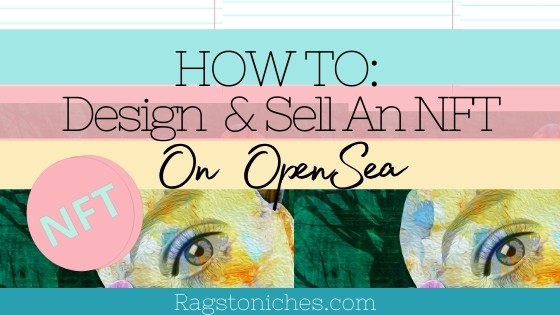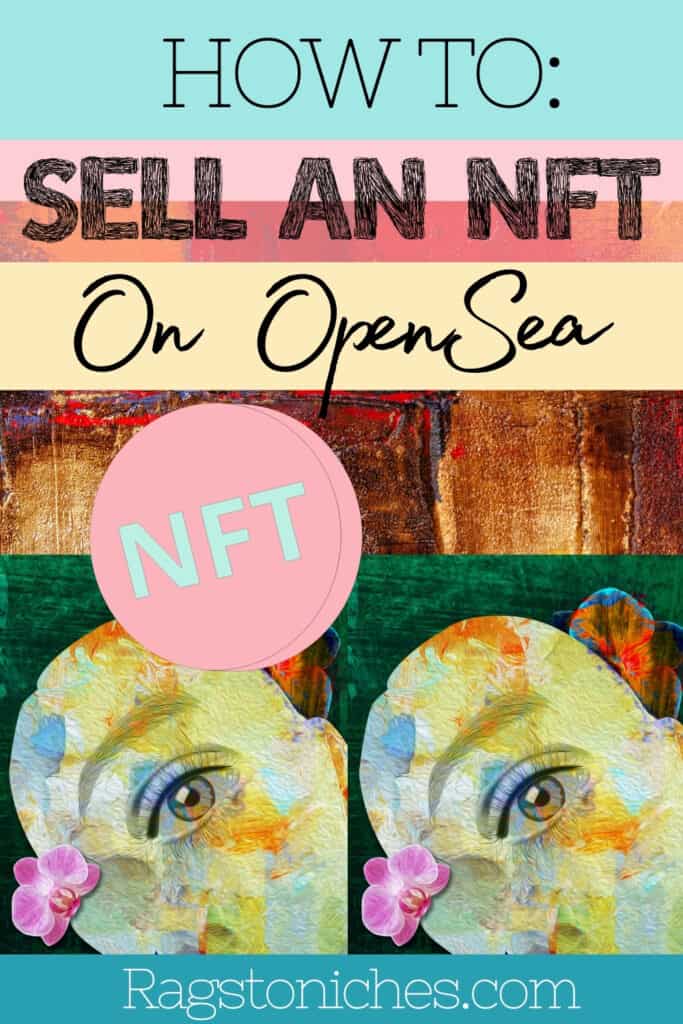
Are you an artist? Do you draw, paint or create digitally? Perhaps you create digital art in Photoshop, or even create it the old fashioned way — with pens, pencil or paint! No matter what kind of artwork you create, there are many ways to make money from it.
One very modern way solution, is via selling a product called Non-fungible Token (NFT). To do this, you need to know how NFT works and what it means.
In this blog post, I’ll cover everything I know about NFT and how you can create them and sell them on OpenSea.
What’s an NFT?
Non-Fungible Tokens are the next step in crypto as they enable trustless transactions on decentralized marketplaces.
They are a new kind of digital item that is unique, virtual, and managed by blockchain technology.
Examples of NFTs include digital art, collectibles, virtual reality items, crypto domain names, ownership records for physical assets, and more.
Each description of an item is intended to highlight its unique features, utility, and most popular uses.
A brief history of NFTs and blockchain art
The history of NFTs and blockchain art is an interesting blend of people understanding the promise of blockchain technology, and artists creating their own art using tokens gifted to them for artistic pursuits.
The concept of NFTs has been with us since December 2012 with the inception of “Colored Coins” — interestingly, a project Vitalik Buterin, the creator of Ethereum, had a hand in building on the Bitcoin blockchain.
It was conceived from the idea of issuing real-world assets like real estate on a blockchain.
Ultimately, the limitations of Bitcoin’s scripting language were inadequate to sustain the application. However, the concept of Colored Coins opened possibilities for experimentation and laid the groundwork for successful NFTs in the Future.
CryptoKitties in 2017 marked the NFT mainstream moment, These little guys have been making waves since December of 2016 when they were introduced in a post on r/Bitcoin on Reddit.
The crypto kids got into the hype machine and now they’re ready for prime time. The media is talking about crypto, everyone is talking about crypto now.
Cryptokitties went viral and raised $12.5 million in investment.
One unique and quirky feature about CryptoKitty virtual cats are …. You can breed them!
They have a unique number and 256-bit distinct genome with DNA and different traits — “attributes” (pattern, mouth shape, fur, eye shape, base color, accent color, and more) which are passed onto their digital feline offspring.
CryptoKitties quickly became so popular that it caused an increase in pending transactions on Ethereum, accounting for over 10% of network traffic on the Ethereum network and threatening to crowd out other applications.
Ethereum miners increased the gas limit in response, allowing more data per block and increasing transactions per second. Marketplace sites like OpenSea which will be discussing in this article, and RareBits sprang up to support the new phenomenon.
How Do You Get Started on Opensea?
Opensea is one of several marketplaces where you can create and sell your NFTs, (as well as collect and purchase ones yourself).
You must have three essential things in place if you want to buy or sell NFTs on OpenSea.
Ethereum
Ethereum is a blockchain, and ETH is the currency used to make transactions on the Ethereum blockchain.
Ethereum downplays its status as a cryptocurrency, instead emphasising that it’s more like a software platform.
This opens up a world of possibilities for businesses interested in creating apps using Ethereum as a means of contract programming. You will need ETH to purchase an NFT, and for gas fees to complete the transaction
Gas fees
Gas is the largest cost for any cryptocurrency transaction. It’s an unavoidable cost that regardless of technical approach our decentralized technological systems have no way around
Think of gas fees as Ethereum blockchain transaction costs. They are determined by supply/demand across the network (blockchain).
Opensea account
Let’s head over to opensea.io and create a new account, it will prompt with a screen to connect our crypto wallet
A crypto wallet is an application or hardware device that allows individuals to store and transfer digital assets like cryptocurrencies and Non-Fungible Tokens (NFTs).
Security: Keeping your funds safe
It’s a good idea to write down and safely store your seed phrase in multiple places when you first download your wallet.
Some wallets offer seed phrases as an extra feature.
Others will ask for them if you follow the steps in their documentation.
Others still will be able to generate addresses for you without asking for them, but no additional information beyond the generated address will be stored on your computer or in any location other than your wallet, so if you can’t find it, search online for info or reach out to your wallet provider before buying NFTs or storing digital currencies.
Never share your password or seed phrase with anyone.
If you forget your password, you can always enter your 24-word BIP39 seed phrase into a compatible wallet to regain access.
Below are some of the supported wallets to use with Opensea
Connecting Your Wallet
You will continue through multiple prompts, When you see “Connecting… OpenSea to your wallet”, We’re almost done!
Your account will default to “Unnamed”, showing only your wallet address below. To personalize your account, select the gear icon on the right side of the screen.
You will receive an extra security prompt, select “Sign” and you can begin updating your profile.
Final Touches
Next, you’ll customize your account so that it reflects your unique style and personality.
Creating Your NFT
Go to opensea.io/collections to create your first collection.
Name your collection and describe its purpose, and upload an image – we’re not making NFTs at this point; we’re just setting up your collection for you to display your work,
Here I’m creating my own collection called 8-Bit Star Ship
Creating NFTs
To create a new NFT, click Add New Item. You can upload metadata about the file, like an image or video file, and enter the name of the NFT. After, you can also add an external link and enter a description.
Each purchaser needs to identify which NFT is associated with which work, hence the existence of the edition number in the stats section of each asset page.
This helps buyers and sellers to find works that have already been sold or in the process of being sold when looking for an asset with a similar (or identical) name.
Many digital marketing agencies and interior designers will tell you that having multiple levels on a property makes it easier for buyers to filter your work. Having different spaces on the same property allows the buyer to view your portfolio from different angles
It’s also possible to add unlockable content that can include one-time-use promotional codes, contact info for redeeming physical items, access keys.
Once you’ve created your first NFT, it will be visible under the search bar. There’s no charge for creating NFTs, so this won’t incur any gas fees (transaction costs).
Selling Your NFTs
Once done, Click Add New Items and you’ll be taken to your collection’s main panel.
After, click on the sell button up top and you will receive the following page:
Choose between a fixed-price listing or auction and set your price then press “Post”, if you’ve never sold on OpenSea before, you’ll need to pay a gas fee before you can list.
Currently, the transaction fees to create a trading smart contract are expensive, but you’ll only have to do it once.
When you accept an offer on an item you haven’t previously listed, you will be asked to approve Wrapped ETH (Wrapped ETH, which is used for making offers on OpenSea), as well as the pay gas fee for accepting the offer. Buyers pay the gas for fixed-price listings, sellers pay when accepting offers.
Purchasing Ethereum (ETH)
Search the internet for a reputable and regulated seller in your region and purchase slightly more ETH than the amount quoted when you press ‘Post Your Listing”.
The gas fee required for setting yourself up for trading fluctuates between $50 – $250 due to network congestion.
Art isn’t about leaderboards, but collectors often use the OpenSea rankings page to discover new and exciting creators.
It’s a steep ascent to the top, but lots of traders filter by ‘New’ and ‘7 – DAY CHANGE’, so there’s ample opportunity to get yourself in front of buyers if you can generate a few early sales with some grassroots marketing on your side!
Sell your crypto-collectibles without paying gas
Now you can auction an item without paying any gas*. Instead of executing an on-chain transaction (which costs ETH to pay for gas), you simply sign a message digitally, which is later “settled” on-chain by the buyer of the item.
For sellers who want to sell a large number of items, the overall cost is dramatically reduced.
Expire auctions automatically
Now your auctions truly expire! When you set a duration for a declining price auction, it will automatically cancel itself once the specified duration ends.
In escrow-based marketplaces, you have to pay gas to cancel auctions, even those with a specified duration.
This includes reducing the price on auctions you set too high, which is now a click away…
Some of the supported gasless categories:
- CryptoKitties
- Decentraland
- Crypto Space Commander
- CryptoStrikers
- Eth. Town
- CryptoBots
- Cryptovoxels
- Mythereum
- MakersPlace
- CryptoArte
- CryptoFighters
- And many more.
Is now a good time to get into non-fungible tokens?
In an online speculatory market, fintech startups and corporations are competing for control of the ecosystem—whether bitcoin or otherwise. One area where companies are attempting to secure a bigger piece of a decentralized pie, is non-fungible tokens or NFTs.
If you had told me a year ago that non-fungible tokens would be the next big thing in crypto, I would have called you crazy.
But it looks like we’re on the cusp of a massive revolution in cryptocurrencies, and non-fungible tokens are right in the middle of it.
Article written by: Daniel Awde.
Pin Me For Later:

Spot on with this write-up, I really think this site needs a great deal more attention. I’ll probably be returning to read more, thanks for the
info!